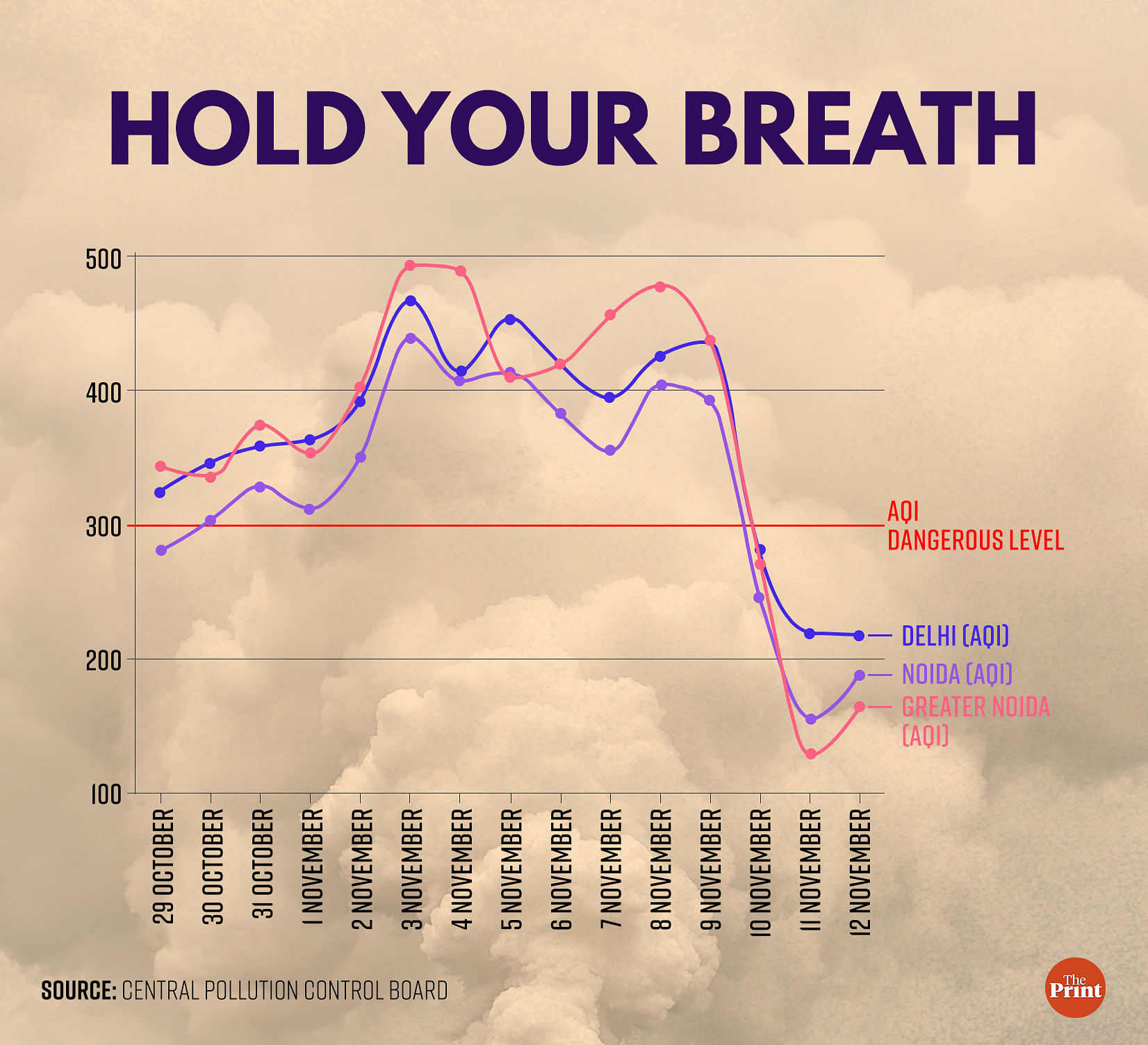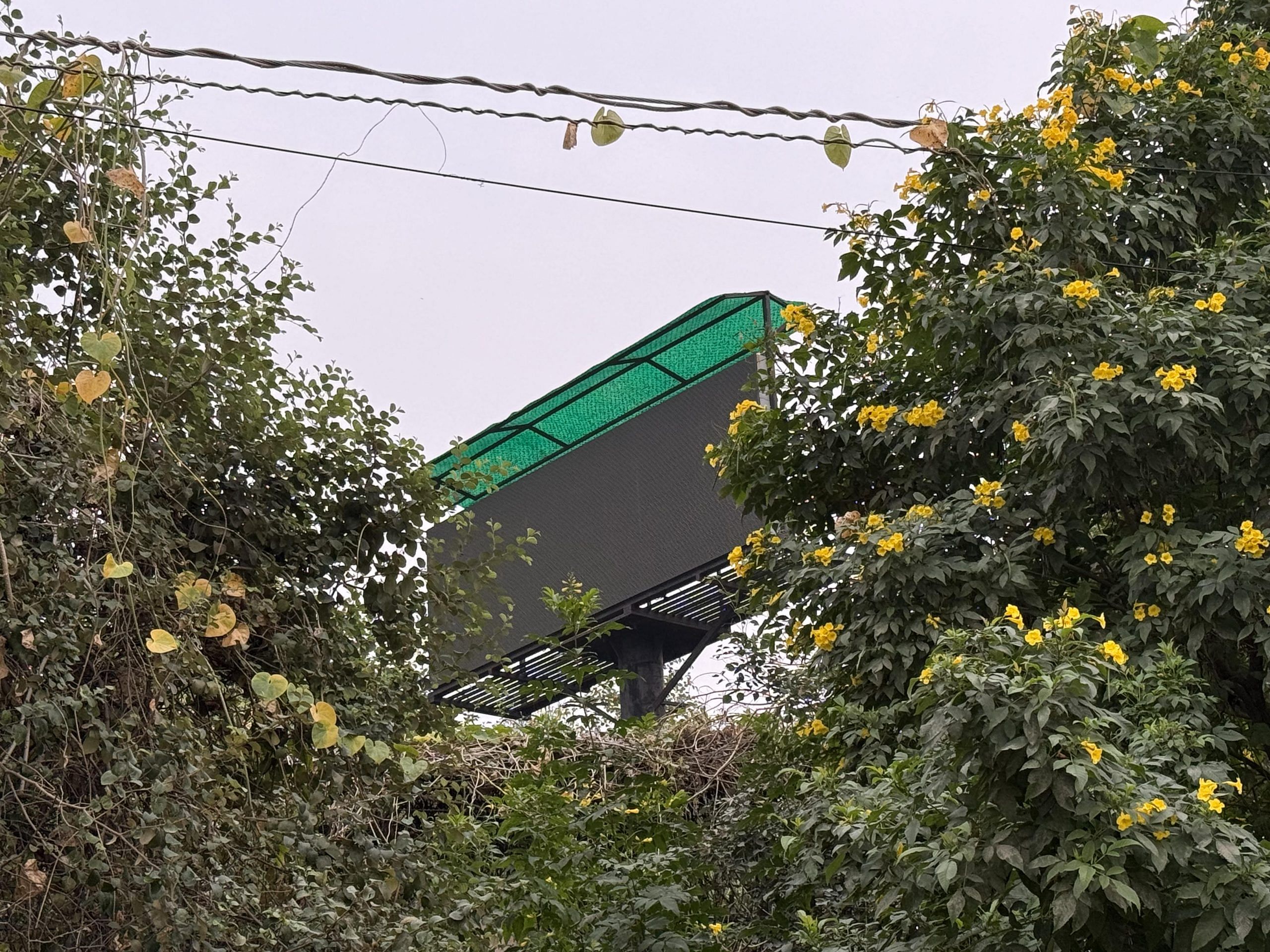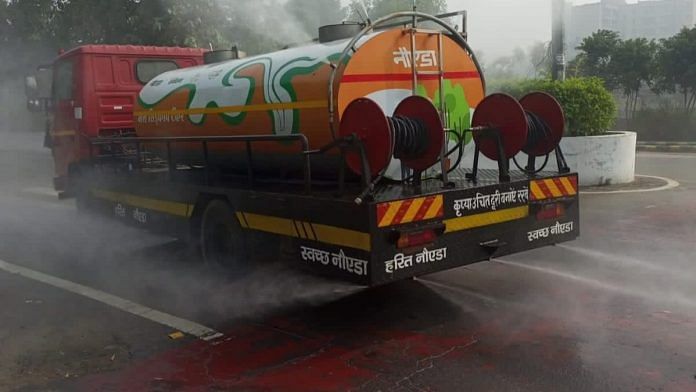A pall of smoke envelops the high rises, metro stations and the expressways, hiding the city in a veil of haze. Except this isn’t Delhi. This is Yogi Adityanath’s buzzing city of Noida-Greater Noida, the poster boy of ‘transforming UP’.
Delhi is no longer the sole benchmark for polluted air in India. Amid the smog of air pollution debate that doesn’t tell where the buck finally stops for the capital’s toxic air, Noida-Greater Noida is silently recording higher AQI levels every day. In the first 15 days of November alone, Greater Noida has surpassed the Delhi AQI levels seven times, the worst being 494 on 3 November when Delhi was recorded 468 – taking GreNo to the list of the most polluted cities in the country. On the remaining days, the AQI of Noida-Greater Noida has been closer to Delhi’s, if not less.
“Tumhe clean air bhul jaani padegi, Delhi-NCR mein aakar toh dekho” sung by two young men from NCR encapsulates the situation of these NCR towns. Noida-Greater Noida is the new bad boy of pollution, matching Delhi and Gurugram, AQI to AQI. The smog machines and water sprinklers are washing off the streets and the construction sites. Radio stations are running special programmes on air pollution. Local dailies are calling it a nightmare. And residents are blaming Delhi and Punjab, one cough at a time. One of the two AQI monitoring centres in Greater Noida is not working and the officials are clueless.
“Greater Noida is a developing city. There are a lot of construction projects which have contributed to the high pollution levels and there is no denying that. We have put a ban on construction for another 15 days. The city was coming under control but bursting of crackers on Diwali made it worse,” says Regional Officer Dev Kumar Gupta, sitting in the Regional Office of UP Pollution Control Board in Greater Noida.

Also read: Mumbai doesn’t want to become Delhi. BMC, Bombay High court crack down on AQI
Waste is the urban stubble here
With PM 2.5 levels rising, the Noida-Greater Noida residents are not leaving it to the gods or the authorities to save their lungs.
Anupama Bhardawaj’s has her daily routine set out. On Radio Noida 107.4, she runs a special show called Mere Aasman on air pollution, talking to experts from Noida-Greater Noida. At home, she keeps an eye on the residents and sends messages on water sprinkling routines.
Bhardawaj, who is also president of Super Deluxe Flats society in Noida Sector 15 A, is the one-woman army. On her instructions, every morning, the residents sprinkle their courtyard and the patch of road outside their main gates. The guards wash the areas adjacent to the three society gates.
Bhardwaj calls it the efforts of “residents to bring the pollution down.”
“We strongly encourage all residents, especially those on the ground floor, to participate in this effort by sprinkling water in their lawns and nearby spaces. When outdoors, please ensure to wear masks for your safety,” reads one of her advisory messages to the residents group on WhatsApp.
That politics has entered the Noida air is visible in people’s understanding of the pollution debate.
Bhardwaj is convinced that it is Punjab’s stubble burning that has caused the problem and “the Uttar Pradesh government is helpless.”
“We are choking. But the Punjab government is not doing anything. Uttar Pradesh can’t do much in this,” she says.
Bhardawaj is among several others who are blaming Punjab farmers and government for the current air crisis, seemingly unaware of her developing city.
Environmentalist Vikrant Tongad says that Punjab and Delhi should not be blamed as Noida-Greater Noida has its own sources of pollution contributing to the spike.
“There is a huge construction sector in Greater Noida that is the main source of the dust. After that, the traffic jams at Noida film city and Kisan chowk in Gaur city in Greater Noida. The traffic is at peak in these places and the authorities have not been able to do much,” says Tongad.
Tongad has participated in the District Environment Committee meetings with Gautam Buddha Nagar District Magistrate Manish Verma and Regional Officer Dev Kumar Gupta. And he has given his reasons for the poor air quality levels: Construction activities, traffic jams, open waste burning and public transport because of low metro connectivity.
There is a huge construction sector in Greater Noida that is the main source of the dust. After that, the traffic jams at Noida film city and Kisan chowk in Gaur city in Greater Noida. The traffic is at peak in these places and the authorities have not been able to do much
— Vikrant Tongad, Environmentalist
While there is not much stubble burning in Noida-Greater Noida, Tongad points at the open waste burning that the authorities have not been taking into account. He along with other concerned citizens has been raising the issue for some time now but feels that it is all falling on deaf ears.
“There is no proper solid waste management system in Noida-Greater Noida which is growing at a fast pace. The waste is being burnt in open areas. In Greater Noida, a railway track near Roza Jalapur village, the waste is burnt. In Noida, contractors have dug deep holes at the open construction sites around Sector 105 where the solid waste is burnt.”
He says that the administration is taking a reactive approach during the smog season instead of a proactive one.
“There is water pollution in Noida-Greater Noida. Waste is being dumped into water bodies. The authorities become active during smog season. But only when the authorities work all year round, something will happen. Blaming other cities and states won’t go a long way,” he says.
Also read: NHRC’s image crisis has peaked. In 30 years, ‘toothless tiger’ to ‘not even ornamental’
Measuring pollution with broken systems
At the office of DM Manish Verma, plans are being made to change the placement of pollution monitoring devices in Greater Noida. For three consecutive days, before and after Diwali, the pollution monitoring centers at Knowledge Park V and Knowledge Park III were closed.
The officials were celebrating Diwali and Govardhan Pooja, says an official requesting anonymity. Another official in the Greater Noida administration says that the officials knew that after Diwali there would be a spike in the AQI levels, so they deliberately kept the center closed.
Verma might not does not officially agree to these reasons but he says that the pollution levels in Greater Noida are not as high as the devices are showing. According to him, the devices are placed in areas that would make “Greater Noida” look bad by showing high AQI levels.
“If you go one kilometer ahead from Knowledge Park V, the AQI will show a dip. How is that? The devices have been placed where there is a lot of incoming traffic, construction activities. So, it shows the AQI of that area and not the city as whole,” says Verma.

Delhi has 40 air monitoring centres of which several are located in dense areas such as Okhla, Anand Vihar, Narela, Sonia Vihar, among others.
Meanwhile, Verma says that there were few patches where stubble was burning in Greater Noida and the government has sent them notices.
“We are buying stubble from farmers through 16 government registered Gaushalas (cow shelter). We have provided decomposers to farmers and have also held chaupals to create awareness,” he says.
Yet the air pollution levels are not going down.
The DM has instructed the District Pollution Control Board to look in to the technicalities of the AQI monitoring devices. At the Pollution Control Board office in Greater Noida, Regional Officer Gupta is monitoring the work of anti-smog gun and sprinkling devices in the city.
On his WhatsApp group ‘GRAP implementation’, Assistant Engineers are sending updates on the areas which are being sprinkled. Around 67 government anti-smog guns have been stationed at several construction sites in Noida-Greater Noida and two dozen water sprinklers are taking rounds of the cities.
GRAP or Graded Response Action Plan, which is also active in Delhi, are a series of measures that kick in once air pollution reaches worrying levels.
But it doesn’t seem to be bringing relief. A resident of Yogi’s constituency of Gorakhpur, Gupta took charge as the Regional Officer in July this year. Since then, he has given CTE (Consent to Establish) certificates to around 100 construction businesses, including around a dozen small ones. But a construction ban is in place now and the GRAP has been implemented, he says.
Also read: Green tops, imported grass, better seats—Cricket stadiums upped the game but fans want more
Your air, my air everywhere
The blame against Delhi and Punjab is at the heart of all the problems and Gupta has a geographical explanation to offer.
“There is no denying that the AQI levels in Greater Noida are higher but it’s Punjab’s stubble burning that is at the heart of it. The geography of Noida-Greater Noida is like a bowl. Pollution reaches here and stays because of low wind speed,” he explains scrolling his GRAP WhatsApp group.
‘Your city is polluting mine’ is the go-to refrain politicians are using to deflect the blame. On 4 November, speaking at an event in Ghaziabad, CM Yogi Adityanath said that “his eyes started burning as soon as he stepped out of his aircraft (in Ghaziabad).”
“I realised it was due to smog. When I checked NASA satellite images to see areas affected by stubble burning and industrial pollution, it was found that the whole of Punjab and northern parts of Haryana were indicated in ‘red’.”
The environment minister in Delhi Gopal Rai has blamed UP for air pollution. “He (Yogi Adityanath) does not see the pollution in Greater Noida being caused by buses and construction activities…”
Meanwhile, Gupta is looking for another site for the air pollution monitoring center as the one at Knowledge Park V is glitched and shut temporarily. Officials cite glitches but some of them admit off record that it was higher AQI levels that forced them to shut it.
Also read: Rachin Ravindra was not named after Sachin. But this World Cup, he is breaking Tendulkar’s records
A divided citizenry
Sitting in his sofa, Ruchin Tyagi is fighting two battles — air pollution, by plugging the air purifier; and attending to frequent messages on his WhatsApp from friends, colleagues and relatives. Tyagi, a resident of Greater Noida, has taken it upon himself to educate people on the rising levels of AQI.
“Look at this WhatsApp message. He is calling me a fool for questioning the administration,” says Tyagi, showing a message by his colleague who also lives in Greater Noida.
Twitter and WhatsApp groups have become a battleground with people fighting over which state government to blame. But Tyagi believes that blaming Delhi is not the solution but questioning the local authorities is.
“Everyone is talking about pollution in Delhi. Nobody is talking about the pollution in Greater Noida. It is far worse and dangerous,” says Tyagi.
A day after Diwali, Tyagi posted a video of his society in Greater Noida West, enveloped in smoke with the caption, “AQI in Gr Noida is spiked. This is the view of Central Park in my society. Thick layer of smog with unprecedented smog of crackers. This is sickening. Who are we blaming for pollution?”
Everyone is talking about pollution in Delhi. Nobody is talking about the pollution in Greater Noida. It is far worse and dangerous
— Ruchin Tyagi, resident
He received comments such as “Blame stubble burning in Punjab and not crackers.” Another comment read, “The crackers burst only one day. Try to adjust in adverse conditions. Kal ko WW-3 start ho gaya toh kaise rahoge? (If tomorrow World War 3 starts, how will you live?”)
In another NCR city of Faridabad, Vasu Sharma, a music producer, and Nirbhay Garg, Hindustani classical musician, sang a pollution parody, a satire on air quality.
Sharma says that two weeks ago when he came back from Himachal, he fell sick because of smog and that’s when he wrote the lyrics. It was his friend Garg, a Hindustani classical musician who gave it a kawali touch and the song became viral on Instagram.
“The idea was to spread the message that we are choking and the air pollution is really bad. No body is talking about it but only blaming. We chose kawali to be the means to spread the message because it has the energy to attract people. We shot the video in our studio in Faridabad.”
A line from the song underlines the political blame game on pollution.
“Vote maange aate jo neta aate thay ghar mei, phone unko ab tum laga ke toh dekho (The politicians who used to come home for votes, now you try to call them.)
“It is infuriating to see politicians blaming each other instead of coming together to help us. And that’s why we wrote those lines. During elections, politicians come to your house for votes but now, they are not even picking up the call and when they do, they start blaming the other city or political party. It’s insane,” says Sharma.
The kawali has given Sharma and Garg, a new found fame. They are now on TV channels spreading their message, urging politicians to come together.
In Greater Noida, Tyagi fights a battle on multiple fronts – pacifying those angry with his pollution arguments on WhatsApp and X (formerly Twitter) while buying medicines for his 75-year-old mother who is having difficulty breathing. And writing a petition and a complaint regarding pollution levels.
But because clean air doesn’t seem to be coming anytime soon, she is planning to take his family to Ranikhet for clean air.
“I will work from home but at least my family will breathe clean air. The air purifiers aren’t effective. And if need be, I will shift my base to some other state. The situation is dire here”.
(Edited by Anurag Chaubey)






